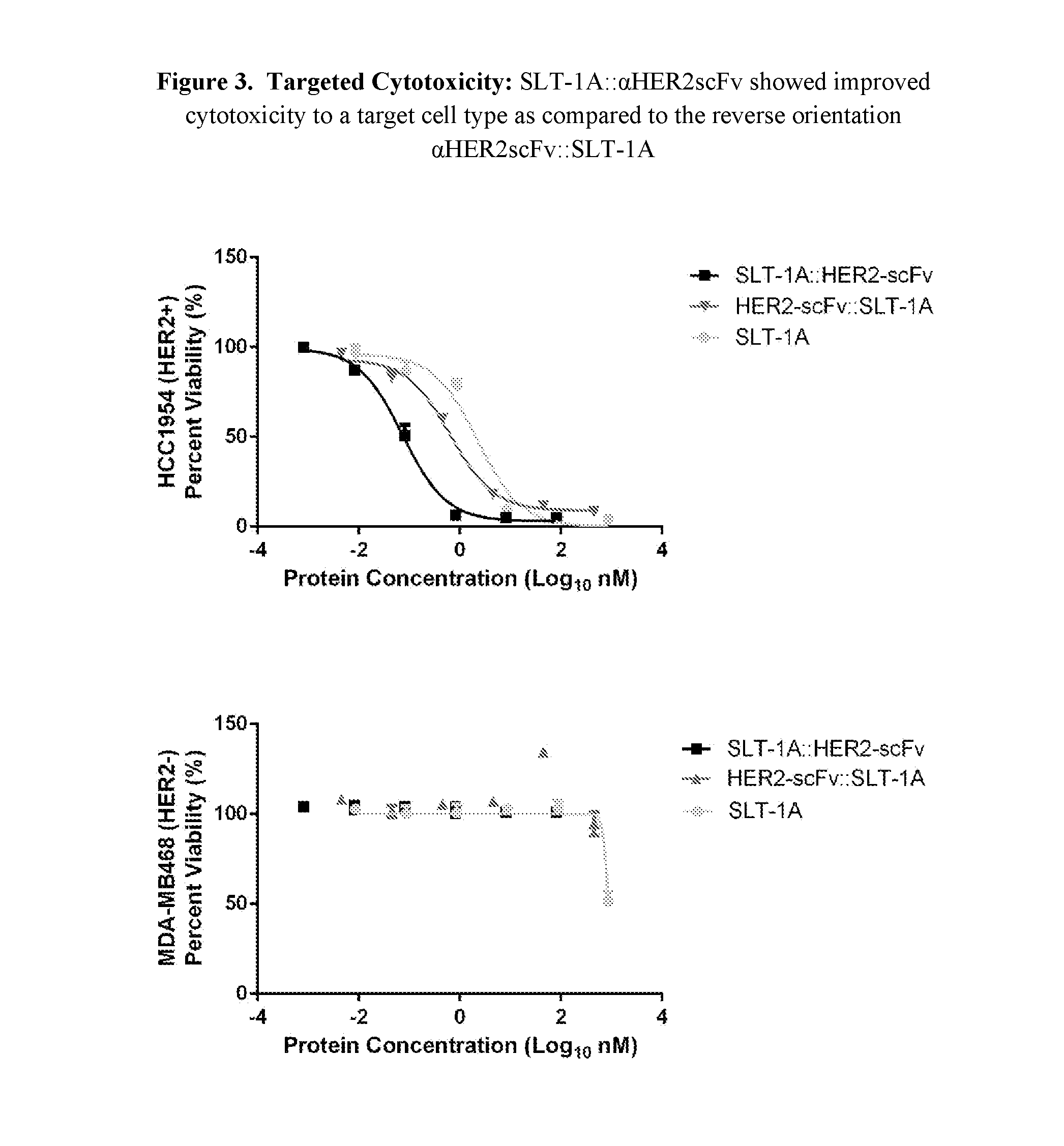Proteins comprising amino-terminal proximal shiga toxin a subunit effector regions and cell-targeting immunoglobulin-type binding regions
a technology of effector regions and proteins, which is applied in the direction of peptide/protein ingredients, depsipeptides, fusion polypeptides, etc., can solve the problems of unreported components, unreported cytotoxicity, and unreported toxin-based proteins to the orientation, so as to reduce or eliminate the cytotoxicity of the shiga toxin region, promote cellular internalization, and reduce or eliminate catalytic activity
- Summary
- Abstract
- Description
- Claims
- Application Information
AI Technical Summary
Benefits of technology
Problems solved by technology
Method used
Image
Examples
example 1
A CD38-Targeted, Cytotoxic Protein Derived from the A Subunit of Shiga-Like Toxin-1 (SLT-1A::αCD38scFv)
[0260]The cytotoxic protein of this example SLT-1A::αCD38scFv comprises a Shiga toxin A Subunit fragment recombined with a single-chain, variable fragment, binding region capable of binding CD38 with high affinity such that the Shiga toxin effector region is more proximal to the amino-terminus of the cytotoxic protein than the CD38 binding region.
Construction, Production, and Purification of the Cytotoxic Protein SLT-1A::αCD38scFv
[0261]First, a Shiga toxin effector region and an immunoglobulin-type binding region were designed or selected. In this example, the Shiga toxin effector region was derived from the A subunit of Shiga-like Toxin 1 (SLT-1A). A polynucleotide was obtained that encoded amino acids 1-251 of SLT-1A (Cheung M et al., Mol Cancer 9: 28 (2010). An immunoglobulin-type binding region αCD38scFv was derived from the monoclonal antibody anti-CD38 HB7 (Peng et al., Blood...
example 2
A HER2-Targeted, Cytotoxic Protein Derived from the A Subunit of Shiga-Like Toxin-1 (SLT-1A:αHER2scFv)
[0277]The cytotoxic protein of this example SLT-1A::αHER2scFv comprises a Shiga toxin A Subunit fragment recombined with a single-chain, variable fragment, binding region capable of binding HER2 with high affinity such that the Shiga toxin effector region is more proximal to the amino-terminus of the cytotoxic protein than the HER2 binding region.
Construction, Production, and Purification of the Cytotoxic Protein SLT-1A::αHER-2scFv
[0278]In this example, the Shiga toxin effector region was derived from the A subunit of Shiga-like Toxin 1 (SLT-1A). A polynucleotide was obtained that encoded amino acids 1-251 of SLT-1A (Cheung M et al., Mol Cancer 9: 28 (2010)). An immunoglobulin-type binding region αHER2scFv was derived from trastuzumab (marketed as Herceptin®, Genentech, South San Francisco, Calif.) monoclonal antibody as described (Zhao et al., J Immunol 183: 5563-74 (2009)) such th...
example 3
A CD19-Targeted, Cytotoxic Protein Derived from the A Subunit of Shiga-Like Toxin-1 (SLT-1A:αCD19scFv)
[0294]The cytotoxic protein of this example SLT-1A::αCD19scFv comprises a Shiga toxin A Subunit fragment recombined with a single-chain, variable fragment, binding region capable of binding CD19 with high affinity such that the Shiga toxin effector region is more proximal to the amino-terminus of the cytotoxic protein than the CD19 binding region.
Construction, Production, and Purification of the Cytotoxic Protein SLT-1A::αCD19scFv
[0295]In this example, the Shiga toxin effector region was derived from the A subunit of Shiga-like Toxin 1 (SLT-1A). A polynucleotide was obtained that encoded amino acids 1-251 of SLT-1A (Cheung M et al., Mol Cancer 9: 28 (2010). An immunoglobulin-type binding region αCD19scFv was derived from the humanized, monoclonal antibody anti-CD19 4G7 (Peipp M et al., J Immunol Methods 285: 265-80 (2004) and references therein) such that a single-chain variable fra...
PUM
| Property | Measurement | Unit |
|---|---|---|
| Length | aaaaa | aaaaa |
| Composition | aaaaa | aaaaa |
| Cytotoxicity | aaaaa | aaaaa |
Abstract
Description
Claims
Application Information
 Login to View More
Login to View More - R&D
- Intellectual Property
- Life Sciences
- Materials
- Tech Scout
- Unparalleled Data Quality
- Higher Quality Content
- 60% Fewer Hallucinations
Browse by: Latest US Patents, China's latest patents, Technical Efficacy Thesaurus, Application Domain, Technology Topic, Popular Technical Reports.
© 2025 PatSnap. All rights reserved.Legal|Privacy policy|Modern Slavery Act Transparency Statement|Sitemap|About US| Contact US: help@patsnap.com



